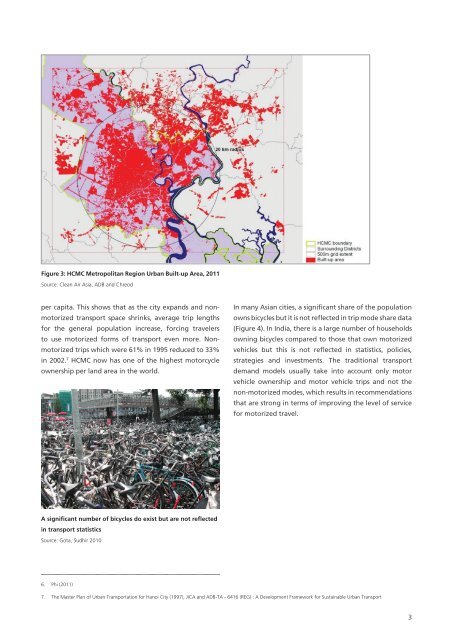Promoting Non-motorised Transport in Asian Cities
Shakti Sustainable Energy Foundation conducted a study to assess the viability of promoting non-motorised transport in Asian cities. As part of the study, they undertook a project – Nehru Place Placemaking. See more at: http://shaktifoundation.in/report/promoting-non-motorised-transport-asian-cities-policymakers-toolbox/
Shakti Sustainable Energy Foundation conducted a study to assess the viability of promoting non-motorised transport in Asian cities. As part of the study, they undertook a project – Nehru Place Placemaking. See more at: http://shaktifoundation.in/report/promoting-non-motorised-transport-asian-cities-policymakers-toolbox/
Create successful ePaper yourself
Turn your PDF publications into a flip-book with our unique Google optimized e-Paper software.
Figure 3: HCMC Metropolitan Region Urban Built-up Area, 2011<br />
Source: Clean Air Asia, ADB and Chreod<br />
per capita. This shows that as the city expands and nonmotorized<br />
transport space shr<strong>in</strong>ks, average trip lengths<br />
for the general population <strong>in</strong>crease, forc<strong>in</strong>g travelers<br />
to use motorized forms of transport even more. <strong>Non</strong>motorized<br />
trips which were 61% <strong>in</strong> 1995 reduced to 33%<br />
<strong>in</strong> 2002. 7 HCMC now has one of the highest motorcycle<br />
ownership per land area <strong>in</strong> the world.<br />
In many <strong>Asian</strong> cities, a significant share of the population<br />
owns bicycles but it is not reflected <strong>in</strong> trip mode share data<br />
(Figure 4). In India, there is a large number of households<br />
own<strong>in</strong>g bicycles compared to those that own motorized<br />
vehicles but this is not reflected <strong>in</strong> statistics, policies,<br />
strategies and <strong>in</strong>vestments. The traditional transport<br />
demand models usually take <strong>in</strong>to account only motor<br />
vehicle ownership and motor vehicle trips and not the<br />
non-motorized modes, which results <strong>in</strong> recommendations<br />
that are strong <strong>in</strong> terms of improv<strong>in</strong>g the level of service<br />
for motorized travel.<br />
A significant number of bicycles do exist but are not reflected<br />
<strong>in</strong> transport statistics<br />
Source: Gota, Sudhir 2010<br />
6. Phi (2011)<br />
7. The Master Plan of Urban <strong>Transport</strong>ation for Hanoi City (1997), JICA and ADB-TA - 6416 (REG) : A Development Framework for Susta<strong>in</strong>able Urban <strong>Transport</strong><br />
3

















